What is it acute generalized exanthematous pustulosis?
Acute generalized exanthematous pustulosis, or AGEP, is rare pustular drug eruption characterized by superficial pustules.
AGEP is generally classified as severe cutaneous adverse reaction (SCAR) to a prescription drug. It is also called toxic pustuloderma
The first signs of acute generalized exanthematous pustulosis
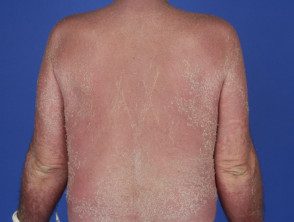
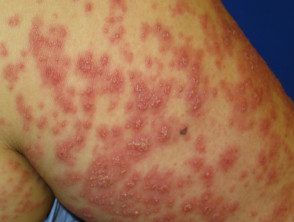
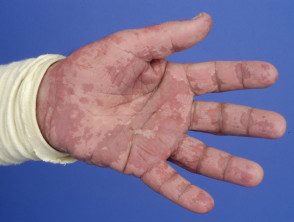
Who gets acute generalized exanthematous pustulosis?
AGEP has an estimate incidence 3 to 5 cases per million inhabitants per year. It occurs in men and women, children and adults.
What causes acute generalized exanthematic pustulosis?
More than 90% of AGEP cases are caused by medications, often beta-lactam antibiotics (penicillins, cephalosporins, and quinolones). Other medications that can cause AGEP are reported to include:
- Tetracyclines
- Sulfonamides
-
Oral antifungals, particularly terbinafine.
- Calcium channel blockers such as diltiazem.
- Hydroxychloroquine
- Carbamazepine
- Paracetamol.
The onset of AGEP generally occurs within 2 days of exposure to the responsible drug.
Viral infections (Epstein-Barr virus, enterovirus, adenovirus, cytomegalovirus, hepatitis B viruses and others) are common triggers of AGEP in children. Spider bites have also been implicated in some cases. There is a suspicion that some herbal remedies may have caused AGEP.
Recent research suggests that AGEP is associated with IL36RN gene mutations. These genetic The abnormalities make the patient more susceptible to pustulosis when certain medications are prescribed or when exposed to infection. Similar mutations are also found in some patients with other pustular disorders, such as generalized pustular psoriasis. palmoplantar Hallopeau's pustulosis and acrodermatitis continuum.
What are the clinical features of acute generalized exanthematous pustulosis?
AGEP usually starts on the face or armpits and groin and then becomes more extended. It is characterized by the rapid appearance of areas of red skin dotted with sterile pustules the size of a pinhead. There is usually more disease in the skin folds. Facial swelling often arises.
Oral lesions affect approximately 20% in patients with AGEP.
AGEP may be associated with a fever and discomfort, but often the patient is not particularly ill. Multi-organ involvement is rare but can lead to serious illness.
AGEP persists for one to two weeks and then the skin is peeled off with small collarettes of peeling How is it solved
Morphology of acute generalized exanthematic pustulosis
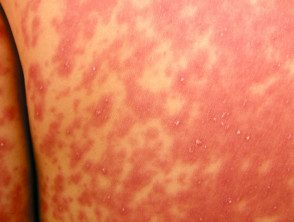
Pinpoint pustules on an erythematous base
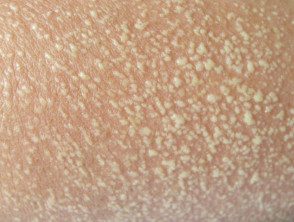
Superficial pustules

Oral lesions in AGEP
What are the complications of acute generalized exanthematous pustulosis?
About 10% of patients with AGEP have a severe organ-associated reaction. dysfunction (lungs, blood, kidneys, liver).
AGEP can overlap with drug hypersensitivity syndrome or Stevens-Johnson syndrome / toxic epidermal necrolysis, which can be fatal.
Secondary infection is rare.
How is acute generalized exanthematic pustulosis diagnosed?
AGEP is often diagnosed clinically. Supporting investigations may include:
- Blood test: neutrophilia and elevated. inflammatory Markers are often found. Eosinophilia and renal or hepatic Abnormalities may be present and should be monitored.
- Biopsy of the skin: subcorneal pustules filled with neutrophils. See dermatopathology of AGEP.
- Patch test: sometimes used to confirm allergy to an agent causing AGEP.
Which is the differential diagnosis for acute generalized exanthematous pustulosis?
Skin conditions that can sometimes be difficult to distinguish from AGEP include:
- Stevens-Johnson syndrome / toxic epidermal necrolysis
- Drug hypersensitivity syndrome
- Another drug rashes
- Generalized pustular psoriasis.
- Neutrophils skin disease
-
Acute located exanthematous pustulosis.
How is acute generalized exanthematous pustulosis treated?
AGEP patients are often admitted to the hospital for a few days, but patients can be cared for at home if they feel well enough to eat and drink.
New drugs should be discontinued after the start of AGEP, particularly antibiotics.
Treatment is based on relieving symptoms with moisturizers, current corticosteroids, oral antihistamines, and pain relievers up to eruption solve Systemic therapy is rarely indicated.
What is the outcome for acute generalized exanthematous pustulosis?
The AGEP rash peels off and resolves spontaneously in about 10 days. It usually does not recur unless the same drug that caused the first episode is taken again. A second episode can be more severe.
Acute generalized exanthematous pustulosis solution

Peeling
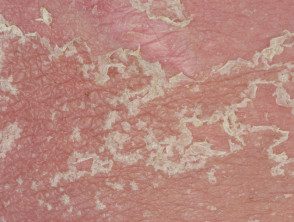
Scale Collarettes
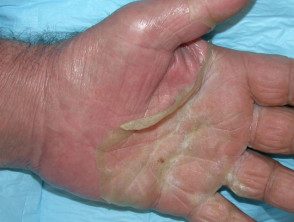
Palmar skin peeling
